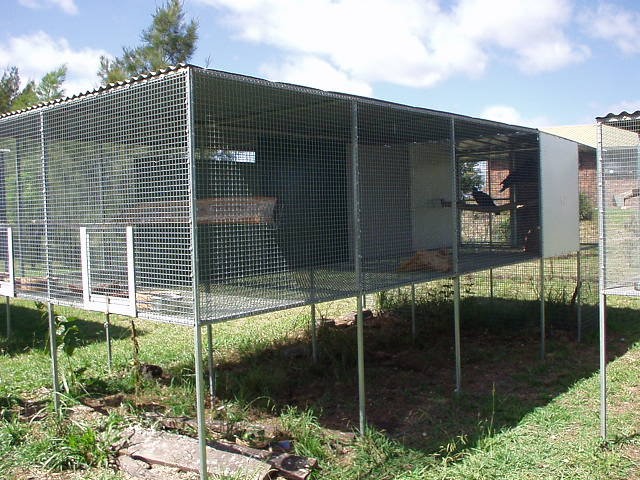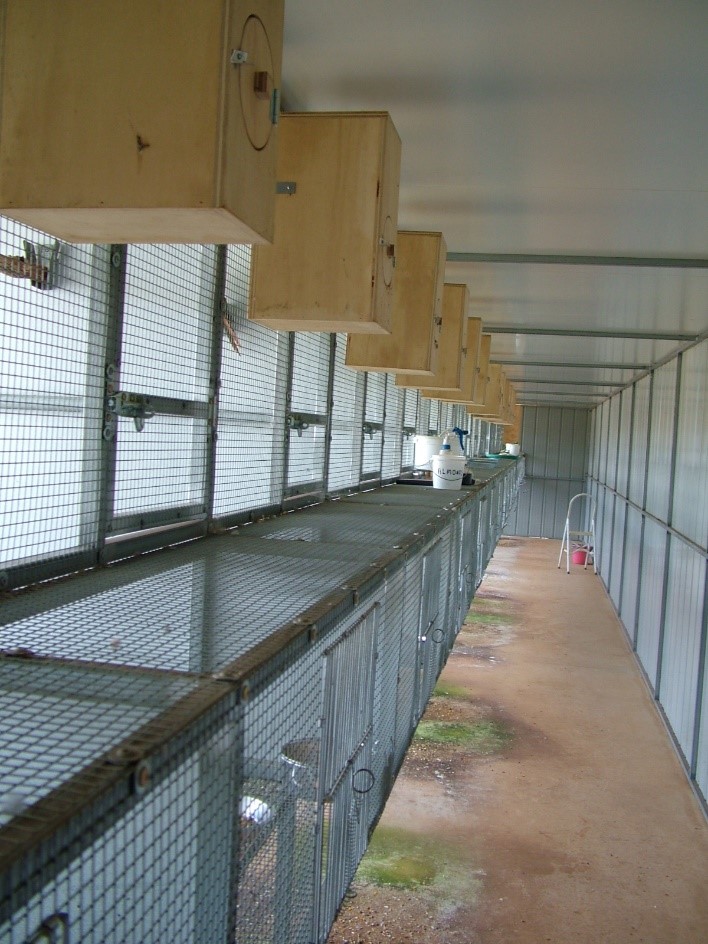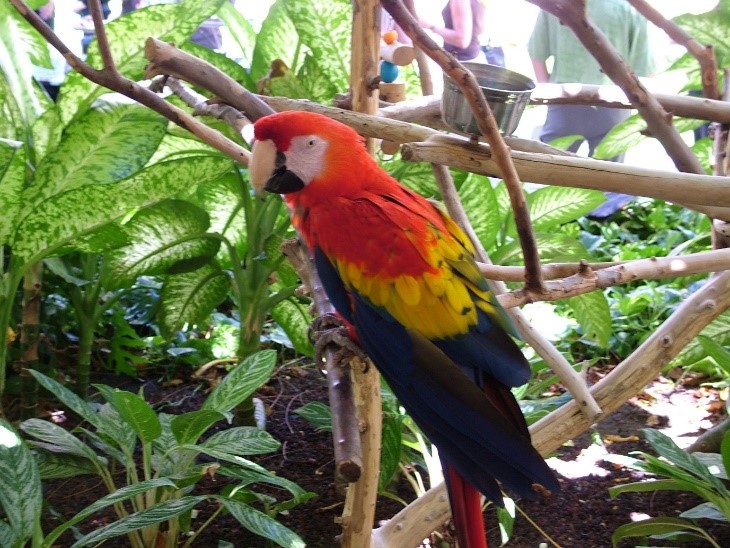Companion birds are most commonly kept in indoor cages and enclosures, although some are housed in either temporary or permanent outdoor enclosures. These cages range from small (outdated) budgie cages to large steel framed macaw cages.
Aviary birds are generally housed outdoors (in Australia) in either full-flight (a solid floor on the ground) or suspended aviaries (suspended wire floors) (see photos showing examples of these below). Full-flight aviary floors can be, from most difficult to care for to easiest to care for, dirt, gravel, sand, or concrete (or a mixture), in order. Full-flight planted aviaries are ideal for small parrots and finches, but larger parrots will usually destroy them. Suspended aviaries have the advantage of been easy to clean and maintain, and the birds may feel more secure in them, but they can be enrichment deprived.


Poultry are kept either as backyard or commercial flocks. Backyard flocks are kept as pets, food producers, or show birds. They can be kept in fixed sheds (usually with a run attached) or in mobile pens. Commercial poultry are kept either in cages or as free range. Cages for poultry have significant welfare concerns.
Pigeons are kept in lofts, similar to free-flight aviaries but more communal and with the ability to release the birds for a daily flight.
Basic considerations for enclosure design
There are several basic considerations that need to be taken into account when setting up an enclosure for birds. These considerations are:
- Where will I put it?
- How do I exclude or control pests?
- What will the enclosure be made of?
Where to put it?
Indoor enclosures
While pet birds can enjoy interacting with their human companions, they can also become stressed by constant noise and movement, lack of privacy and security, irregular day/night (diurnal) cycles and the possibility of the cage been knocked over. Indoor cages should be positioned with these stressors in mind. Some suggestions include:
- Position the cage in a corner of a room, so that at least two approaches to it are secure (i.e., no one will approach from the two sides against the walls).
- Keep the cage off main traffic routes through the house, reducing close contact with people and other pets and potential stress from their activity and proximity.
- Have a day cage and a night cage, so that birds can be ‘put to bed’ (rather than being covered) at nightfall.
Outdoor enclosures
Siting aviaries, backyard poultry pens, and pigeon lofts presents some challenges and considerations, including the following:
- Local council regulations often stipulate where a backyard structure can be built and how big it can be. They may also regulate the number (and even the size) of the birds that can be kept.
- What land is available – not everyone lives on acreage and has loads of space!
- Ideally the open side of aviaries, pens and lofts should face north, maximising exposure to direct sunlight. This helps to keep enclosures dry and allows the birds to engage in normal daytime activities. The closed side of the aviary, on the other hand, should face towards the direction of prevailing weather, offering some protection against rain and wind. Shade and protection against inclement weather should be provided.
Pest control
Bird enclosures are inherently dirty – food and bird droppings attract insects and mice, which in turn attract rats and snakes. Small birds attract big birds – e.g., crows, currawongs, hawks, and falcons. Things that can be done to minimise these problems include:
- Fully roofing aviaries and ensuring there are no overhanging branches.
- Suspended aviaries minimise pest problems, but may compromise the birds’ psychological welfare. Some birds are ground feeders and feel insecure not been able to eat on the ground. Pets and small children running and playing underneath the suspended aviaries can be very stressful to the occupants.
- Concrete floors are easily cleaned and maintained but can be expensive to build.
- Fine mesh wire, sometimes doubly wired, can help to restrict access by rats and snakes. Mice, however, can get through almost anything.
- Rat walls – concrete barriers below ground level to a depth of 30cms – can stop rats and mice burrowing into an aviary.
- Regular cleaning of the aviary floor and avoiding the use of feed hoppers – large dishes of feed that are topped up when emptying – minimise the amount of waste that attracts pests.
- Careful use of humane mice/rat control can assist, but care must be taken to ensure that the birds do not become inadvertent victims (e.g., ingesting toxic baits). For more information on humane rodent control see this article.
Enclosure design and construction
The safety of the birds is influenced heavily by the design and construction of the enclosure.
The frame can be of wood, metal, or PVC construction. While wood is the cheapest and easiest to work with, it has several disadvantages: the birds can chew it; it is often treated with preservatives that can be toxic; it cannot be disinfected; and it can harbour external parasites such as the Red mite (Dermanyssus spp). Please see this article for more information on parasites that can affect birds.
There are several requirements for wire: it must be strong enough to withstand chewing by the species in the enclosure; it must be small enough to prevent wild birds entering the enclosure; it must be rust proof, but not so heavily or poorly galvanised that the zinc poses a toxic threat to the birds; and it should be ‘see through’ (this can be achieved by painting it black).
Aviary roofs can be either partial or complete. This means that the roof is either solid across the entire length or it is partially solid, and the rest is wire. The latter design allows sunshine and rainfall to reach the birds, allowing a more natural effect, but the disadvantage is wild birds, possums and rats running along the open top and potentially soiling the aviary and/or scaring the birds. Some aviculturists reach a compromise by having a small, wire-roofed ‘porch’ or landing where the birds can get into the rain, and then withdraw into cover if a threat presents.
The aviary floor is another area where there are a variety of options to consider, that all have pros and cons. Dirt floors are cheap, but they are impossible to clean (presenting a hygiene and health issue) and allow access to the aviary by mice, rats, or snakes (which is hazardous for your birds). Concrete is expensive and permanent (the aviary can’t be moved) but is easy to clean and maintain and stops rodents and predators gaining access via the floor. Sand and gravel are used by some as a compromise between concrete and dirt. This has to be raked regularly to turn it over and replaced every few months. Weighing up against hygiene and security is environmental enrichment – some birds, especially Australian species, like to forage for food on the ground and for this dirt or sand is best, and this is of great psychological benefit to them.
Regardless of the aviary design, at some stage someone will have to enter it – to clean it, to recover a bird, to check nest boxes, and so on. This means opening a door and which can create a potential escape route for a bird. It is never a good idea to allow a captive bird to go free; not only do captive birds lack the skills needed to survive, but the bird may also be harbouring disease that could be devastating to native birds. For these reasons, responsible aviculturists often have a safety porch or walkway (a corridor running along the back of the aviary, allowing access to each aviary but accessed by only one door) so that they can always maintain a closed door between the bird and the outside world (see photo below for an example).

Perches, while giving the birds somewhere to perch, should not be so numerous that the bird does not see the need to fly (this can lead to obesity and a lack of physical fitness needed for normal life activities, such as egg laying). This can be done by placing one perch at each end of the aviary or by running a perch along one wall. Perches should be positioned so that they do not sit above food and water dishes so that faecal contamination does not occur. The perches should be destructible – it is normal for parrots to chew on them and important that they can do this. Using metal pipe to save having to replace perches is not a sound practice. Perches should be irregular in shape and diameter, to exercise the birds’ feet. The diameter of the perch should be such that the birds’ nails just meet when gripping the perch. The perches should be removed and replaced when they are soiled or badly damaged. Because of these factors, natural branches make the best perches.



